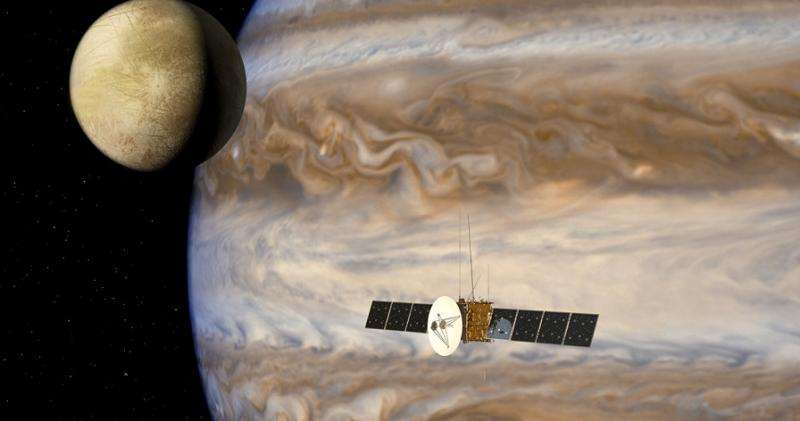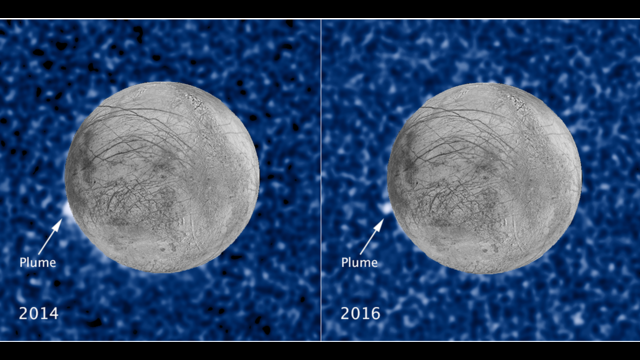ESA's JUICE spacecraft could detect water from plumes erupting on Europa

ESA's JUpiter ICy moons Explorer (JUICE) mission to the Jovian system could easily confirm the presence of water on Europa, a new study finds. According to the research, it is feasible to detect water molecules (H2O) and water ions (H2O+) from the moon's plumes during a flyby mission.
The suspected water vapor plumes erupting on Jupiter's moon Europa are still baffling scientists searching for habitable environments in the solar system. It is assumed that Europa harbors a vast subsurface liquid ocean, and these plumes could be an indicator of water erupting from the moon's interior. Hence, they offer a great opportunity to gather samples originating from under the thick layer of ice, where many mysteries of extraterrestrial life may await to be unraveled.
Recent observations of Europa with the Hubble Space Telescope (HST) show a plume rising about 62 miles (100 kilometers) above the surface. Researchers estimate that these plumes could rise even 125 miles (200 kilometers) before raining material back down onto the icy surface.
According to a new study conducted by a team of European scientists, these plumes should be thoroughly investigated by a future flyby mission like JUICE in order to confirm the presence of water. In a recent paper, the researchers studied the feasibility of in-situ measurements of Europa's plumes by modelling the trajectories of neutral and ionized plume particles and the respective measurements by neutral and ion mass spectrometers.
"Instead of using 'photons' as Hubble does, we will use in-situ particle data. This means that we will validate the presence of water independently using the in situ data. JUICE is the mission that can do this, as it will be equipped with the Particle Environment Package (PEP) instrument suitable for this measurement," Yoshifumi Futaana, co-investigator of the JUICE/PEP instrument at the Swedish Institute of Space Physics told Astrowatch.net.
PEP is a plasma package with six sensors to characterize the plasma environment. It will measure density and fluxes of positive and negative ions, electrons, exospheric neutral gas, thermal plasma and energetic neutral atoms. The package will include the Jovian plasma Dynamics and Composition (JDC) sensor measuring water ions, and the Neutral gas and Ions Mass spectrometer (NIM) sensor measuring water molecules.
Futaana and his colleagues are convinced that the particles of the low mass flux plumes (1 kg/s) can be detected by PEP with large margins. Furthermore, the results of their study suggest the plume signal is recognizable as a temporal signal enhancement of one order of magnitude in the H2O count rate over six minutes. This means that the detection of water plumes during a flyby is, indeed, feasible.

"Our paper shows that the plumes can be detected from the JUICE flybys with particle instruments that detect (water) particles in the vicinity of the spacecraft. This is the case even if the plume is significantly smaller than what has been observed. With this, we mean that the plumes in our work only release one kilogram of water per second, while the very first plume observation indicated 7,000 kilograms of water is released per second," Hans Huybrighs of the Max Planck Institute for Solar System Research in Germany, one of the co-authors of the paper, told SpaceFlight Insider.
The authors of the study emphasize that even in case of relatively small water plumes, the water atoms dissociating from the molecules, as well as their ions, create significant signals. However, so far, Hubble observations of the plumes detected only atomic oxygen. Given the amount of oxygen and other considerations, it was concluded that these oxygen atoms must arise from dissociated water molecules.
"This would also explain the observed spatial features, which were interpreted as a plume. Even though it is all very plausible, and is not contested in the scientific community, it is an interpretation. PEP on JUICE will be able to confirm this interpretation and provide a lot of additional data to understand the nature of the plume, its composition, and its relation to the subsurface of Europa's ice shell, which is mostly water ice," Peter Wurz of the University of Bern in Switzerland told Astrowatch.net.
The researchers have also shown that the geometry of the plume source does not influence the density distributions. Therefore, it will not affect their detectability when using PEP. They noted that it makes no difference whether it is a point source or a several hundred miles-long crack.
All in all, JUICE equipped in the PEP instrument has the potential to take a peek at Europa's subsurface ocean without drilling the moon's icy shell. This ocean could hold many clues to mysteries of life beyond Earth.
"What is so interesting about this ocean is that it has probably been there for a long time, and that there could be sources of energy for life in it, like geothermal vents on the bottom of the ocean, making Europa's ocean a very interesting environment that is possibly habitable for some form of life," Huybrighs concluded.
JUICE mission is planned to be launched in 2022. The spacecraft will perform two flybys of Europa in early 2031. During these flybys, JUICE is expected to approach Europa up to a height of about 250 miles (400 kilometers).
Source: Astrowatch.net





















